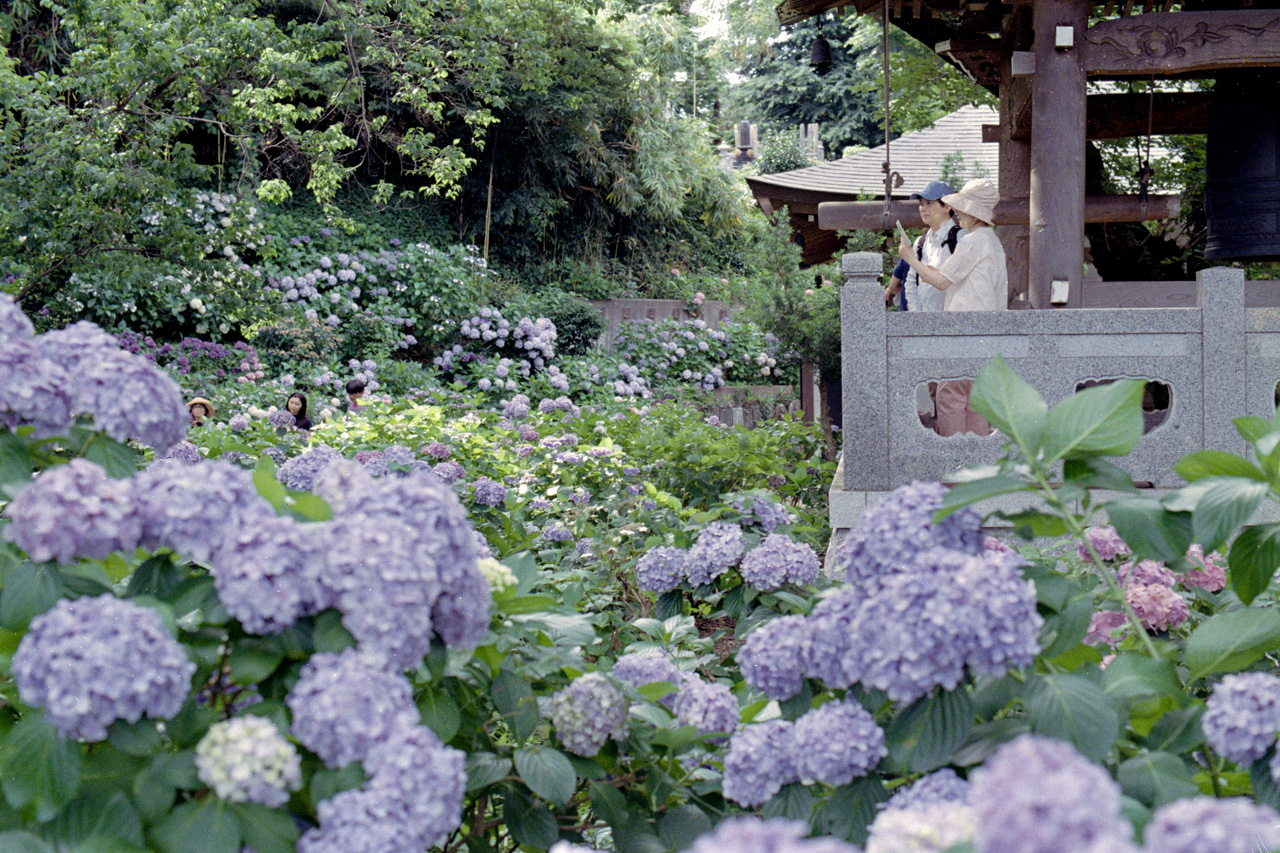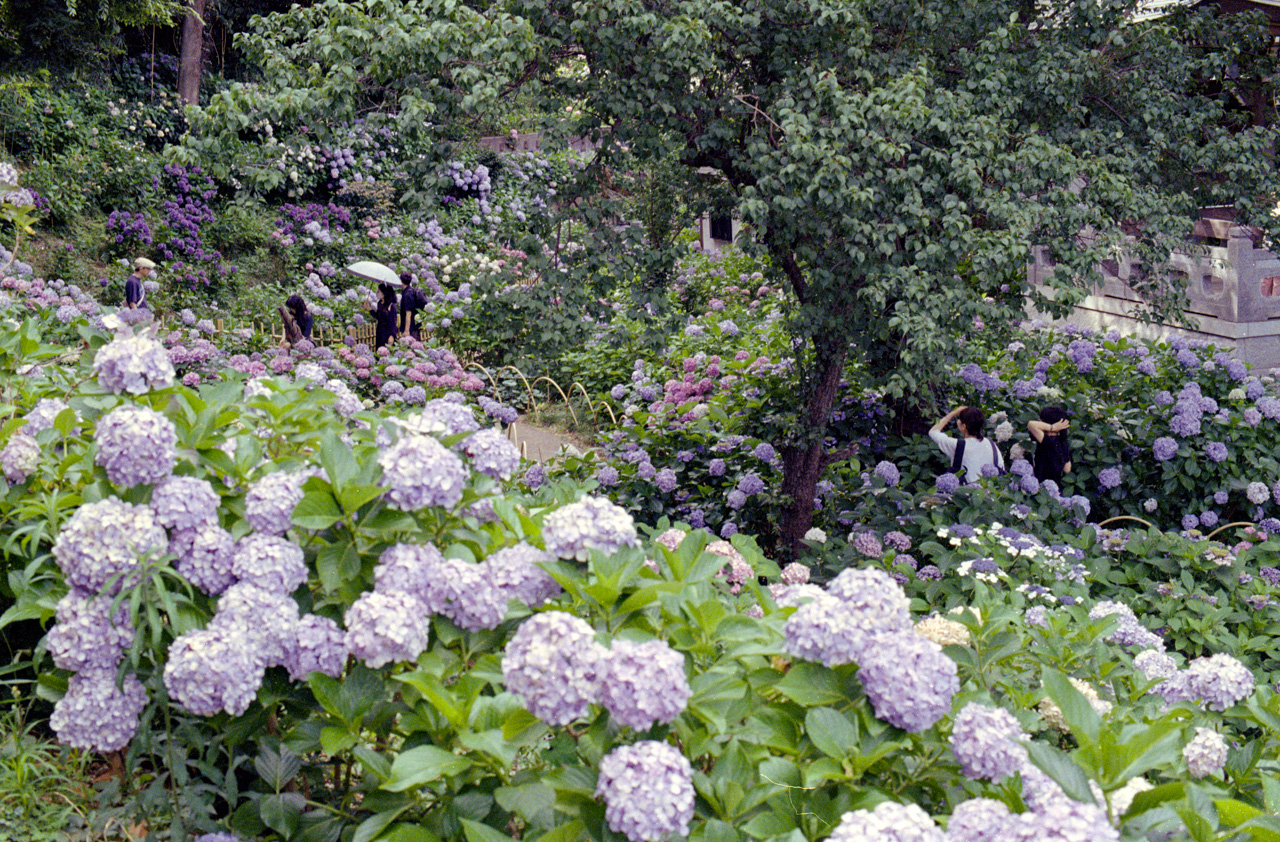The Hidden Temple of Hydrangeas

The rainy season in June and July, when the skies open up and drench the earth, is closely tied to the blooming of hydrangeas, or as the Japanese call them, ajisai. These flowers have been popular for centuries, and not just because they look pretty, but because they symbolize gratitude, apologies, and all those emotions we often keep bottled up inside. Hydrangeas don’t stick around for long. They quickly wilt and fade, reminding us of life’s fleeting nature and the importance of cherishing each moment. Interestingly, the Japanese have a unique way of enjoying hydrangeas: they bundle them together and float them in a shallow dish of water. It’s called ukibana, and it’s like a mini floating garden. In the Edo period, people even used them to create a special indigo color for paper and textiles. The color was highly prized. I wonder if they had to use a ton of flowers to get enough dye for one kimono.
Mention hydrangeas, and the famous Hasedera temple in Kamakura springs to mind. It’s like the Hollywood Walk of Fame for hydrangeas — famous, popular, and always packed with fans. Trying to get a good look at the hydrangeas in Hasedera can be a challenge to navigate through the dense crowds. It’s not for the faint of the heart!
This brings us to Myoraku-ji, a temple that I stumbled upon by pure luck. It’s almost hidden, tucked away on a hill in a quiet corner of Kawasaki that rivals Hasedera in its hydrangea display, but without the crowds. The locals have given it a nickname “Ajisai-dera”, meaning “hydrangea temple”.
I visited Myoraku-ji twice. On my first visit, I armed myself with my classic Nikon FM2. It had been about two years since I last shot anything on film, but the hydrangea season seemed like the perfect excuse to dust off the old camera.
From the moment I stepped into the temple grounds, I was struck by all the vibrancy of the ajisai in the garden. In front of me was a green oasis of dense foliage that seemed to have been meticulously arranged by a master gardener. The hydrangeas were at the peak of their bloom. Over 1,000 hydrangeas of 28 varieties cover the entire temple grounds. As I wandered around, trying to find interesting compositions, I knew I needed to come back, but next time, to capture some video footage. I checked the forecast, and rain was on the horizon for at least part of the next day. Perfect, I thought. What better chance to capture the hydrangeas glistening with raindrops?
I came back the following day, ready to capture some moody, atmospheric shots. The rain ended up being a bit of a letdown — it was short and less intense than the dramatic downpour I was hoping for, but the air still felt fresh and crisp, so I can’t complain. If you want to see how it all turned out, go ahead and check out the video.

When you think of temples in Japan, you might picture these sprawling, endless grounds that take hours to explore. Well, Myoraku-ji is like a pint-sized cousin of those grand temples, but its character is undeniable. The paths through the garden are pretty narrow, but that just adds to the charm. When the hydrangeas are blooming, they grow so tall that they practically swallow up the visitors, producing a sort of cartoony scene — all you can see are the tops of people’s heads, their hats, or their umbrellas bobbing along the walkways. Like a floral version of “Where’s Waldo?”
If you go up the path that leads to the top of a steep slope in the garden, you’re rewarded with a stunning panoramic view of the temple grounds. Everyone stops here to snap a photo or ten. You’ll hear the Japanese visitors saying, “Kirei, kirei!” left and right, which basically means “beautiful”. The bell tower is like the centerpiece of the garden, surrounded by the sea of green, blue, purple and pale pink. On the other end of the garden, there is a gate that leads to the main hall of the temple.

I had an interesting moment that day: as I approached the main hall, I started to hear a mix of chanting, rhythmic drumming, and the occasional peal of a bell drifting out from within. It’s the kind of sound that every visitor to Japan should aim to experience at least once – the haunting, hypnotic soundtrack of a temple ceremony. But this time, something about this particular chanting struck me as different. The words being chanted were clearer, more distinctly Japanese than what I had heard in the past. It piqued my curiosity, and I found myself drawn closer to the source.
On the left side of the main hall, I saw a slope with a small forest and blooming hydrangeas. Approaching for a closer look, I noticed that some of the windows on that side of the hall were open and I caught a glimpse of a group of people, all dressed in black, seated inside the hall. The chanting I had been hearing was part of a funeral ceremony.
It was a poignant moment. To witness such an intimate, personal ceremony, even if only for a brief instant, felt like a privilege. This juxtaposition — the beauty of the hydrangeas and the solemnity of the funeral ceremony — was like a reminder that life is a cycle, and it felt like everything was in perfect balance.
After a while, the funeral attendees slowly filed out of the temple. As if on cue, the rain that had been gently falling began to ease up, and eventually, the sun started to peek through the clouds. It was as if the temple and its surroundings had taken a collective breath, shifting from a mood of solemnity to one of peaceful serenity. I stayed around a bit longer before finally heading out.